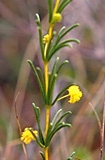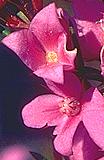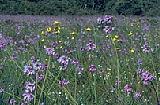|
[Front Page] [Features] [Departments] [SGAP Home Page] [Subscribe]

The Flowering Sands
Barbara Henderson
I can't remember when I first used the word 'wallum' to describe the wildflower areas of my childhood home on Bribie Island - but I can still picture my first red-flowering swamp bottlebrush (Callistemon pachyphyllus) in the Melaleuca swamp behind our little one-teacher school. That was back in the late 1940s. A high school has since replaced the swamp, and I wonder how many schoolchildren of the 1990s now marvel, as I once did, at the island's wildflowers.
Mention 'wallum' and people look at you as though you've just uttered something foreign. In fact, it is a very Australian word, believed to come from the Aboriginal word for Banksia aemula, which we call the wallum banksia. Wallum grows in wet, peaty, sandy soils or in the drier deep sands of high dunes where nutrient levels are low and the water table is high. After good rains, the water table often rises above ground level, turning some wallum areas into semi-swamps. In Western Australia, where it is known as 'kwongan', this precious and beautiful coastal plant community is famous for its wildflowers. On the east coast, it extends from central Queensland through New South Wales to Victoria, along the southern coastline, and into Tasmania and South Australia, particularly Kangaroo Island. In the southern states, it is called 'coastal heath'.
 |
The wallum banksia, Banksia aemula is a common coastal species of Queensland and New South Wales. Select the thumbnail image or plant name for a higher resolution image (59k)
Photo: B.Henderson.
|
To developers, wallum is 'rubbish' and must be 'improved' by draining, clearing and covering with soil and houses. After all, it is prime real estate, so close to the sea. If you drive past at 100 kph, wallum vegetation appears dull green, swampy, mysterious. You have to stop and walk among the plants. Some leaves are prickly and can scratch bare, unwary legs, but wallum is actually gentle and friendly.
Close to the colours
You have to get close to find the beautiful cerise flowers of the wallum dog rose (Bauera capitata). Dampiera flowers add touches of blue - either soft and powdery or vivid and electric. Comesperma defoliatum presents its two blue petals on a long, wiry, grass-like stem. A tiny wattle with heathy leaves and bright yellow globular flowers hides among the other vegetation, but find it and you have 'met' the precious Acacia baueri, one of our vulnerable species. The white-flowered wedding bush (Ricinocarpos pinifolius) entrances its admirers when it is in full bloom at the end of August and into September.
In spring, wallum can be a haze of soft lavender when thousands of vanilla lilies (Sowerbaea juncea) produce clusters of starry, vanilla-scented flowers - although this sight is becoming more and more of a memory. There are splashes of bright yellow from goodenias and the many pea flowers of gompholobiums (wedge peas), dillwynias (parrot peas) and pultenaeas with, here and there, a flash of red from the swamp bottlebrush (Callistemon pachyphyllus). August school holidays would see my girlfriend and me walking or cycling to our local 'Boronia Patch' to collect baskets of pink, yellow and white wildflowers, all with their own wonderful fragrance. To me, they were all 'boronias' but even now, more detailed botanical knowledge does not diminish the charm of my favourite wildflowers.
 |
Ricinocarpos pinifolius, the wedding bush, grows in coastal heath from Queensland to Tasmania. Select the thumbnail image or plant name for a higher resolution image (33k)
Photo: B.Henderson.
|
 |
Acacia baueri is a small shrub which may go unnoticed until the bright yellow flowers appear in spring. Select the thumbnail image or plant name for a higher resolution image (21k).
Photo: B.Henderson.
|
The pink wallum boronia (Boronia falcifolia), which my Scottish father called "Swamp Heather", has fine foliage with an unforgettable fragrance which nowadays brings back memories of a charmed childhood. The yellow woolly aotus (Aotus lanigera) is one of the many pea flowers of the wallum and a good season will mean a spectacular display of bright-yellow flowered bushes humming with eager, nectar-seeking bees. The white heath, which I call "Bell-flowered Heath" (Epacris obtusifolia), is a beautiful plant with flower spikes often carrying more than a hundred of the tubular 'bells' - the largest of the Epacris blooms.
 |
The deep pink flowers of Boronia falcifolia make a colourful display. Select the thumbnail image or plant name for a higher resolution image (38k).
Photo: B.Henderson.
|
The broad-leaved swamp banksia (Banksia robur) prefers wet places. Its truly beautiful flower brushes start as a deep blue-green bud spike which opens to reveal a pinkish centre. As the styles gradually open, the brush takes on a soft greeny-gold appearance which ages to rust and, finally, grey. The low, spreading shrub with all five flower stages on it simply begs to be photographed.
Pretty pink trigger plant flowers (Stylidium graminifolium and S.ornatum) have a special pollination technique. When an insect such as a bee touches a sensitive spot in the centre of the four petals, it activates a 'trigger' which deposits a load of pollen on its back. When the insect visits another trigger plant, the pollen is transferred via the same mechanism. Children are fascinated by this action, which can be generated by 'tickling' the flower with a fine piece of grass. I have also found grown men sitting by a trigger plant with their piece of grass, equally entranced.
Another somewhat bizarre group of plants are the sundews (Drosera spatulata, D.peltata and D.binata), with their unique system of obtaining nutrients other than from the extremely poor soils. They exude drops of sticky fluid to trap tiny flies, ants and other small insects which are then digested by the plants.
Flowering feast
Not just sundews but also spiders feed on the insects attracted to the densely flowering wallum shrubs - building neatly patterned webs or even living inside the flowers. White-cheeked Honeyeaters, streaked black and white with a splash of yellow, visit the larger flowers of banksias and callistemons, never settling for long. Yellow-tailed Black Cockatoos feed on the seeds in the woody Hakea pods, protesting noisily when cars approaching along a gravel road through a wallum wetland disturb them. In spring, they might 'float' on to the Banksia oblongifolia bushes on the seaward slope of tiny Emu Mountain to feed on the seeds and whisper to one another - or one might alight on a Banksia aemula to simply nip off a lovely creamy green flower brush and let it fall to the ground. Is there some purpose to this, known only to the cockatoo?
 |
Wildflowers in heathland at Marcoola, Queensland, an area under threat from development. Select the thumbnail image or highlighted name for a higher resolution image (50k)
Photo: B.Henderson.
|
To those who love it, wallum is precious, beautiful, captivating. We weep over its constant destruction and wonder why can't councils, planners and developers see all those wonderful wildflowers. We are biased, selfish - and heartbroken, not just for ourselves, but also for the wildlife which uses the wallum. We see the footprint of a kangaroo in some wet sand and wonder what will become of this animal when roads are built near its regular track to and from its favourite feeding grounds.
Wallum in the garden
Huge areas of wallum have been destroyed through clearing and, although some wallum is protected in National and Conservation Parks, these areas are fragmented, and too often used as dumping spots for garden rubbish. Could we offset these problem by growing wallum plants in our parks and gardens?
Propagation and cultivation are not easy. Many wallum plants are specially adapted to maximum sunlight and low nutrient sandy or peaty soils with a high water table. Standard garden practices, such as mulching or fertilising, can be fatal.
Try replacing heavy, high pH soils with sands and light gravels. This means hard work and significant expense to purchase replacement soil, but people go to these lengths to grow their annuals or roses. Do our own little Australian natives deserve the same consideration? Of course they do.
Wallum/heath plants rather dislike being shaded, to give them as much sun as possible, no trees, and plant them with other low growing heath plants.
Wallum plants are extremely 'friendly', preferring to be grown very close together, definitely not as isolated specimen plants.
Typical wallum habitat is the next thing to swamp. Careful above-ground watering, when needed, may compensate for a high water table.
You may be rewarded by glorious splashes of wallum colour in your springtime garden - but how much more rewarding to enjoy huge expanses of natural and unique coastal heath habitats, with their own scents and colours and attendant wildlife.
For information on your local wallum/heath plants, try contacting your nearest branch of the Wildlife Preservation Society of Queensland or the Society for Growing Australian Plants.
Barbara Henderson spent a rather idyllic and flower-filled childhood on Bribie Island on Queensland's Sunshine Coast. Since returning to her beloved wallum after a hiatus of almost forty years, Barbara finds herself in a "continuing love affair, complete with heartbreaks, with these beautiful flowers". She is active in the Wildlife Preservation Society of Queensland and leads the Wallum and Coastal Heathland Study Group of the Association of Societies for Growing Australian Plants. Callers are often told, with some truth, that "she's somewhere up the Coast, in Emu Swamp"

[Front Page] [Features] [Departments] [SGAP Home Page] [Subscribe]
Australian Plants online - December 1997
The Society for Growing Australian Plants
|